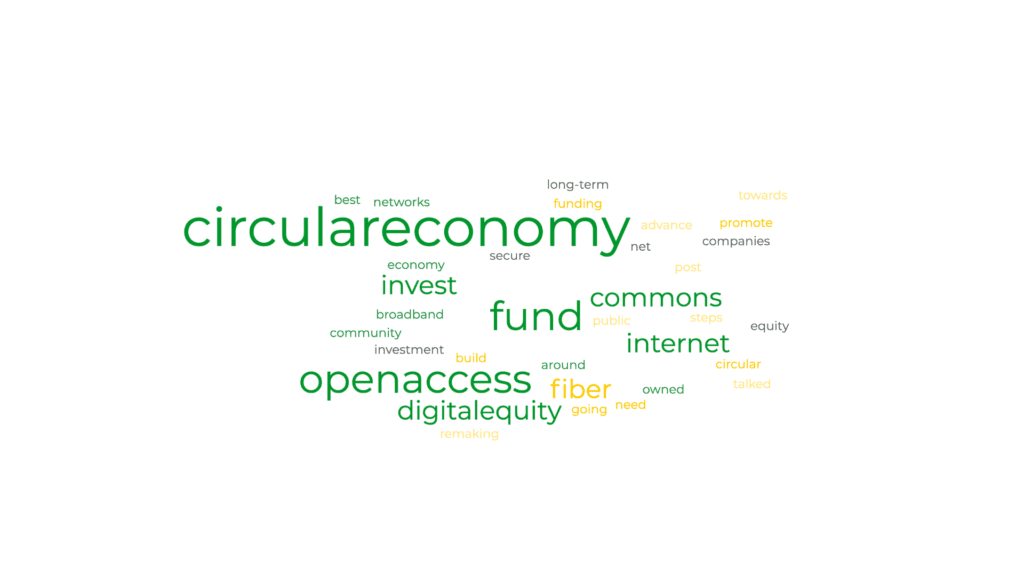The Meaning of Community

The “Community” aspect of Community Internet refers to models of ownership, governance, and control that empower local residents and organizations, as opposed to traditional incumbent Internet Service Providers (ISPs) that often have monopolistic control over geographic areas. Here’s a breakdown of the different ways community Internet can be structured compared to incumbent ISPs:
1. Municipal Broadband
- Ownership and Governance: The local government (municipality) owns and operates the broadband infrastructure and provides service to the community. This can be in the form of a public utility, similar to how some cities manage water or electricity.
- Benefits: Municipal broadband is typically focused on providing equitable access, prioritizing affordability, and closing the digital divide. Local governments can reinvest any profits into the community, improve service, and ensure that broadband is treated as a public good.
- Comparison to Incumbents: Incumbent ISPs often prioritize profit and serve areas where they can maximize revenue, leading to underserved or unserved rural or low-income areas. Municipal broadband aims to overcome these gaps by focusing on universal service, not just profitability.
2. Worker-Owned Cooperative
- Ownership and Governance: In a worker-owned cooperative, the employees own and manage the broadband network. Decision-making is democratic, and profits are either reinvested in the service or distributed among the workers.
- Benefits: Worker-owned cooperatives often emphasize local job creation and sustainable practices. They are responsive to community needs since the workers are part of the community themselves.
- Comparison to Incumbents: Incumbent ISPs typically have centralized corporate structures with decisions made far from the communities they serve, focusing on shareholder profits over local needs.
3. Member-Owned Cooperative
- Ownership and Governance: In this model, the community members (subscribers) collectively own the cooperative. Each member has a vote on important decisions, and profits are reinvested or distributed back to the members.
- Benefits: Member-owned cooperatives ensure that the network operates in the best interests of the community, focusing on affordability, reliability, and universal access. They are particularly common in rural areas, where incumbent ISPs often fail to provide service because of low population density.
- Comparison to Incumbents: Incumbent ISPs, driven by profit, typically neglect rural and underserved areas where they see low return on investment. In contrast, cooperatives focus on service to their members and equitable access.
4. Public-Private Partnerships
- Structure: A public-private partnership (PPP) brings together government entities (municipalities) and private companies to co-invest in broadband infrastructure. In this model, the public sector may provide funding, access to infrastructure, or regulatory support, while the private sector handles operations and technology.
- Benefits: PPPs can leverage the strengths of both sectors. Public entities ensure that social goals like equity and inclusion are met, while private companies contribute technical expertise and operational efficiency.
- Comparison to Incumbents: Unlike monopolistic incumbents, which often fight municipal and cooperative efforts to control local markets, PPPs combine local oversight with professional management, potentially avoiding the profit-driven neglect of underserved areas.
5. Amalgamation of Entities
- Structure: This approach combines several of the above models into a single community-driven network. For instance, a community Internet network might include a municipal backbone, with local cooperatives managing neighborhood-level connectivity, and private partners contributing specialized services like middle-mile connections.
- Benefits: This model allows for flexibility and can be tailored to local needs. For example, a municipal network might provide basic infrastructure, while cooperatives or private ISPs compete to provide the best last-mile services to residents. This model also allows for more robust and resilient networks, where different entities focus on their strengths.
- Comparison to Incumbents: Incumbents tend to monopolize regions, preventing competition and often limiting consumer choices. An amalgamated community Internet model fosters competition and local control, offering more tailored and potentially cheaper services.
Geographic Monopolies of Incumbent ISPs
Incumbent ISPs, like Comcast, AT&T, or Verizon, often maintain geographic monopolies or duopolies, particularly in urban and suburban areas. This allows them to:
- Control Pricing: With little or no competition, these ISPs can charge high rates with minimal incentive to improve service or lower costs.
- Limit Access: ISPs typically focus on densely populated areas where profits are higher, often neglecting rural areas where laying fiber or building infrastructure is deemed too costly.
- Lobbying Power: Incumbent ISPs have successfully lobbied many state governments to pass laws preventing municipal broadband or cooperatives from forming, limiting competition and maintaining their market dominance.
Conclusion
In contrast to the profit-driven monopolistic tendencies of incumbent ISPs, community Internet models—whether through municipal broadband, cooperatives, or public-private partnerships—emphasize local control, affordability, and equitable access. These models are designed to serve the community’s needs rather than prioritize profits, challenging the status quo of geographic monopolies in broadband access.






Responses